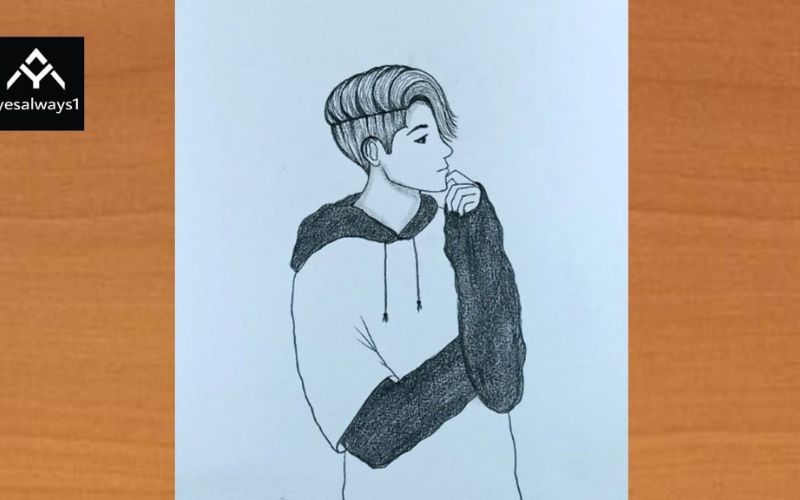Drawing is a timeless form of expression, allowing artists to convey emotions, tell stories, and capture the essence of their subjects. Among the various subjects that artists choose to draw, the human figure, particularly boys, holds a special place. Whether you’re an aspiring artist, a seasoned professional, or simply someone who enjoys the creative process, understanding the nuances of drawing boys can significantly enhance your artistic skills. This article delves into the art of drawing boys, exploring techniques, styles, and inspirations that can help you create compelling and expressive artworks.
Understanding Proportions and Anatomy
The foundation of any good drawing lies in understanding the proportions and anatomy of the subject. When drawing boys, it’s essential to grasp the basic structure of the male body, which differs slightly from that of females, particularly in terms of muscle mass and bone structure.
- Head-to-Body Ratio: The head-to-body ratio varies depending on the age of the boy. For younger boys, the head is typically larger in proportion to the body, while older boys have a more balanced ratio. A common ratio for younger boys might be 1:4 or 1:5, while for older boys, it could be 1:6 or 1:7.
- Facial Structure: Boys tend to have softer facial features than men, with less pronounced jawlines and more rounded cheeks. As they age, these features become more defined. Understanding these subtleties can help in capturing the right age and personality of the boy in your drawing.
- Body Structure: Boys’ bodies are generally leaner and less muscular than those of adult men. However, as they grow, their bodies change, with shoulders broadening and muscles becoming more prominent. Paying attention to these changes can add authenticity to your drawings.
Capturing Emotions and Expressions
One of the most challenging yet rewarding aspects of drawing is capturing the emotions and expressions of the subject. Boys, with their wide range of emotions, from playful joy to deep concentration, offer a rich canvas for artists.
- Eyes: The eyes are often considered the windows to the soul. In drawing boys, eyes can convey a multitude of emotions. Larger, more rounded eyes can give a sense of innocence or surprise, while narrower eyes can suggest concentration or determination.
- Mouth: The shape and positioning of the mouth play a crucial role in expressing emotions. A slight upward curve can indicate happiness, while a downward curve may suggest sadness or contemplation. The subtle differences in the way lips are drawn can dramatically change the overall expression of the boy.
- Body Language: Body language is another vital element in conveying emotions. A boy slouching with his hands in his pockets might be expressing boredom or shyness, while one with an upright posture and open arms could be displaying excitement or confidence.
Exploring Different Styles
Artistic style is a personal choice, and when it comes to drawing boys, there are various styles you can explore. Each style offers a unique way of interpreting and presenting the subject.
- Realism: Realism focuses on capturing the subject as accurately as possible, paying close attention to details like texture, light, and shadow. This style requires a deep understanding of anatomy and a keen eye for detail. Drawing boys in a realistic style can be challenging but rewarding, as it allows you to capture the intricacies of their appearance and emotions.
- Cartooning: Cartooning offers a more exaggerated and stylized approach to drawing. This style is often characterized by simplified shapes, bold lines, and exaggerated features. Drawing boys in a cartoon style allows for more creative freedom, making it easier to emphasize certain traits or emotions. This style is particularly popular in comics, animation, and children’s books.
- Anime/Manga: Originating from Japan, the anime/manga style is known for its distinct features, such as large, expressive eyes, spiky hair, and dynamic poses. Boys drawn in this style often have a youthful and energetic appearance, with an emphasis on movement and expression. This style is particularly effective for storytelling, as it can convey a wide range of emotions and actions.
- Abstract: Abstract art is less about capturing the physical likeness of the subject and more about conveying the essence or emotion. When drawing boys in an abstract style, artists often use shapes, colors, and lines to represent their subject. This style allows for a more interpretive and emotional approach, where the focus is on the feeling rather than the form.
Techniques for Drawing Boys
Mastering the art of drawing boys involves a combination of observation, practice, and experimentation. Here are some techniques that can help you refine your skills:
- Gesture Drawing: Gesture drawing is a technique where you quickly sketch the basic form and movement of the subject. This exercise helps in capturing the dynamic poses and energy of boys, particularly in action scenes. The goal is not to create a detailed drawing but to understand the flow and movement of the body.
- Shading and Lighting: Understanding how light interacts with the form is crucial in adding depth and dimension to your drawings. Boys’ faces and bodies can be shaded to show the contours and create a more lifelike appearance. Experimenting with different lighting setups can dramatically change the mood and focus of your drawing.
- Line Work: The quality of your lines can significantly impact the overall feel of the drawing. Softer, more fluid lines can convey a sense of youthfulness and innocence, while sharper, more angular lines might suggest strength or determination. Experimenting with different line thicknesses and styles can help you find the right balance for your drawing.
- Textures: Adding textures to your drawing can enhance the realism and depth. For example, the texture of hair, clothing, and skin can be depicted through different shading techniques, such as cross-hatching, stippling, or blending. Paying attention to these details can make your drawing more engaging and lifelike.
Finding Inspiration
Inspiration is the driving force behind any artistic endeavor. When it comes to drawing boys, inspiration can be found in various places:
- Photography: Photographs provide a rich source of reference material, offering insights into different poses, expressions, and lighting conditions. Studying photographs of boys can help you understand the nuances of their appearance and capture them more accurately in your drawings.
- Life Drawing: Drawing from life, whether it’s a quick sketch in a park or a more formal life drawing session, can significantly improve your skills. Observing boys in their natural environment, with their spontaneous movements and expressions, can provide valuable insights and inspiration.
- Artworks: Studying the works of other artists, whether contemporary or classical, can offer new perspectives and ideas. Analyzing how different artists have approached the subject of boys can inspire you to experiment with new techniques or styles in your own work.
- Literature and Film: Stories and characters from books, movies, and animations can also serve as a source of inspiration. The personalities, emotions, and actions of boy characters in literature and film can spark ideas for your drawings and help you create more dynamic and expressive artworks.
Challenges and Overcoming Them
Like any art form, drawing boys comes with its challenges. However, understanding these challenges and finding ways to overcome them can lead to growth as an artist.
- Capturing Likeness: One of the most common challenges is capturing the likeness of the subject, particularly in realistic drawing. This requires a keen eye for detail and a deep understanding of anatomy and proportions. Practice, patience, and constant observation are key to improving this skill.
- Conveying Emotion: Another challenge is effectively conveying the emotions of the boy in your drawing. This involves not just capturing the facial expressions but also the body language, posture, and overall mood. Experimenting with different poses, expressions, and compositions can help you achieve this.
- Maintaining Consistency: If you’re working on a series of drawings or a comic strip, maintaining consistency in the appearance of the boy can be challenging. This requires careful planning and attention to detail, ensuring that the proportions, features, and style remain consistent throughout.
- Finding Your Style: With so many different styles and techniques to choose from, finding your unique style can be daunting. The key is to experiment with various approaches, learn from others, and gradually develop a style that feels authentic to you.
Conclusion
Drawing boys is a rewarding artistic endeavor that offers endless possibilities for creativity and expression. Whether you’re interested in realism, cartooning, anime, or abstract art, understanding the nuances of proportions, anatomy, emotions, and techniques is crucial in creating compelling and lifelike drawings. By observing the world around you, practicing regularly, and experimenting with different styles and approaches, you can continue to refine your skills and find your unique voice as an artist. Ultimately, the art of drawing boys is about capturing the essence of youth, energy, and emotion, bringing your subjects to life on the canvas.



